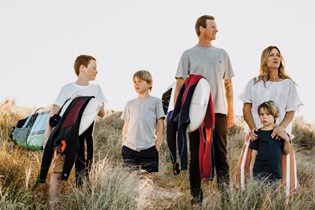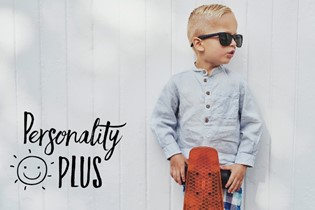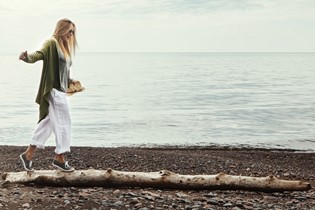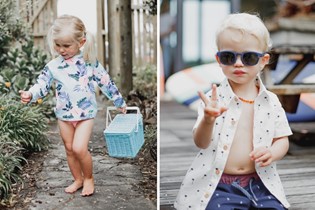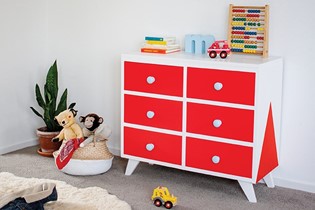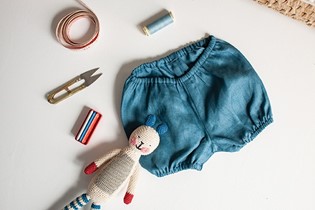How to: swaddle like a pro

Dorothy Waide explains the benefits of swaddling and shares instructions for her favourite configurations.
One of the big questions new parents often ask themselves is whether or not to swaddle their baby for sleep. Swaddling has many benefits but often attracts debate. Whether you choose to swaddle or not ultimately comes down to what you feel is right for your baby. When done correctly, I believe swaddling is comforting and reassuring for newborns, and in my experience, it works particularly well for babies under eight weeks who are unsettled.
Some studies show that swaddling enhances sleep by controlling your baby’s startle (Moro) reflex, and may also help lower the risk of Sudden Unexplained Infant Death Syndrome (SUIDS). Swaddling can also be one of your baby’s first sleep cues which, as they grow, can then be replaced by a sleeping bag. Different kinds of swaddles will provide different levels of physical and emotional comfort, and much will depend on your baby’s particular personality.
When correctly done, swaddling will not overheat your baby, as long as you don’t overdress them, cover their head, or overheat the room they sleep in. I recommend using breathable fabrics such as muslin, light cotton or cotton/merino. The type of material you use will also depend on the time of the year, and the temperature of your home. Using polyester fabrics such as polar fleece is not recommended because this type of fabric may contribute to your baby overheating.
I like to use a flat swaddle cloth made of a natural fabric that breathes, and which measures about 120 by 120cm – you'll find that anything smaller than this will easily unravel, plus your baby will outgrow it quite quickly. Of the many modern purpose-made swaddles available today, my favourites are the Snuggle Wrap from Dimples by Jane Anne (dimples.co.nz), and the Love to Dream swaddle, available from leading baby stores.
When choosing the type of swaddle that best suits your baby, a key point to consider is how much freedom of movement the swaddle provides. If you're using a flat swaddle cloth, it's best to leave it flowing loose from the waist down so your baby can move their hips and legs. This can help with gas release and digestive issues, and also ensures there is no undue pressure on the hips.
For all types of swaddle, it's important to ensure your baby's legs and hips are not restricted. Newborn joints are very flexible because of the hormone relaxin, so it is also recommended to avoid swaddles that are folded up at the base, or are narrow or restrictive in the leg area. These types of swaddles technically place a baby’s legs in a standing position (straight and pressed firmly together), which may contribute to developmental problems such as hip dysplasia and dislocation.
Another important safety tip when you're using a swaddle cloth, is to be sure to wrap it around your baby's chest securely enough so it won't ride up over their face, but loose enough to allow movement for chest expansion. Babies love that feeling of security which emulates the womb.
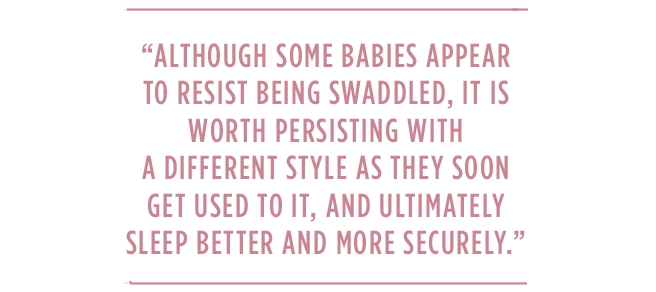
Although some babies appear to resist being swaddled, it is worth persisting with a different style or technique, as they soon get used to it, and ultimately sleep better and more securely.
In my experience, babies who aren't swaddled may wake themselves up more often by involuntarily flailing their arms about due to their startle reflex.
The following three swaddling techniques are some of my favourites, and are for use with a flat, breathable cloth, measuring 120 by 120cm.
CROSS YOUR HEART SWADDLE — ARMS ACROSS CHEST/TUMMY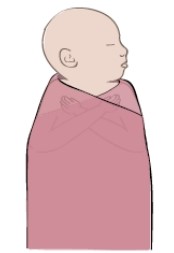
A more traditional swaddle which cocoons your baby's arms against their body.
- Fold down 15cm of fabric from the top of the square.
- Place your baby in the middle, their shoulders positioned 5cm lower than the top fold.
- Place one of your baby’s arms across their chest.
- Gently but firmly draw the swaddle diagonally across the chest (over the folded arm) and tuck it securely under the opposite armpit, being sure to secure it all the way through to the back. You may need to lift and roll your baby’s body as you tuck it under.
- Next, place the opposite arm across the chest so that it sits below or above the first arm. Being sure to give the fabric near your baby's ear a tug to create tension in the fabric, draw the other side of the swaddle across the chest as you fold it diagonally across the front of your baby’s body (over the folded arm). Take the excess fabric upward toward the top of the shoulder and secure it firmly behind your baby's back. Alternatively, just tuck the excess fabric firmly behind their back. The swaddle is deliberately left loose and flowing at the bottom.
- As you pick up your baby, be sure to anchor the edge of the swaddle firmly across your baby’s back so it doesn’t unravel.
SNOW ANGEL SWADDLE — ARMS-UP POSITION
This swaddle is ideal for older babies and also if you are transitioning from the Love to Dream swaddle before going into a sleeping bag.
- Fold down 15cm of fabric from the top of the swaddle. This will create the ‘snow angel’ fold into which you will tuck your baby’s raised arms.
- Place your baby in the middle of the swaddle making sure their shoulders are positioned about 5cm lower than the top of the fold.
- Take one of your baby’s arms and tuck it up inside the fold (so you can no longer see it) then, starting at your baby’s elbow, trace the edge of the fold outwards until you reach the corner of the swaddle cloth.
- Take this corner and place it under your baby’s body. Tuck it firmly under your baby’s lower back.
- Next, starting from the top of the nappy line, trace the edge outwards until you come to the edge of the cloth, and fold it across your baby’s body, over the chest but make sure it's no higher than the nipples, and tuck it firmly under your baby’s body.
- Repeat for the second side. Again, the swaddle is deliberately left loose and flowing at the bottom to ensure no undue pressure is placed on the hip joints and to allow freedom of movement in both the hip and tummy area.
- As you pick up your baby, be sure to anchor the edge of the swaddle firmly across your baby’s back so it doesn’t unravel, and your baby stays snug.
With both arms outstretched and tucked up under the fold, your little cherub resembles a snow angel.
STRAITJACKET SWADDLE — ARMS BY SIDES
Some babies love this position, but I don’t recommend using it unless the swaddling material allows them to move their arms toward their chest as they are drifting off to sleep. Of the three swaddling methods I've described, this one is the most challenging for a baby to ‘break out’ of. If you do use this position, it’s important to know your baby cannot lie on their side, as they would have their body weight lying all on one arm. For this reason, the straitjacket swaddle is recommended for back sleeping only.
- Fold down 15 cm of fabric from the top of the square.
- Place your baby in the middle, their shoulders positioned 5cm lower than the top fold.
- Starting on the first side, place one of your baby's arms alongside their body.
- Gently but firmly draw the swaddle across your baby's chest and tuck it securely under the opposite armpit, being sure to secure it all the way through to the back. You may need to lift and roll your baby’s body as you tuck it under.
- Place the other arm alongside your baby’s body.
- To make the swaddle as secure as possible, tug the swaddle near your baby’s ear to give tension to the fabric as you wrap it across, and then under, your baby’s body. Again, you may need to lift and roll your baby’s body to tuck the fabric under them, and remember to leave the swaddle loose and flowing at the base to allow freedom of movement in the hip and tummy area.
- As you pick up your baby, be sure to anchor the edge of the swaddle firmly across their back, so it doesn’t unravel.
|
TRANSITIONING FROM THE SWADDLE ☙ Swaddle with one arm out of the wrap. ☙ Progress to both arms out. ☙ Take away the swaddle completely and pop baby in a sleeping bag. For babies who find it harder to transition, I suggest lightly tucking them in with a large muslin cloth for a few days. |
SLEEPING BAGS
Sleeping bags replace sheets and blankets, and make your baby's cot a safer environment by removing the chance of blankets covering your baby's face.
Many sleeping bag manufacturers use a TOG (Thermal Overall Grade) rating to describe the weight of the fabric, and therefore the warmth. The higher the TOG rating, the warmer the sleeping bag. TOG ratings go from 0.5 to 3.5.
It's important to ensure your baby's sleeping bag is the correct size, with a fitted neck and armholes, and that it's made with breathable fabric. Do not use a sleeping bag made of polar fleece, or a sleeping bag with a hood. Today’s sleeping bags are designed to cover a wide age group, and most come with underarm domes for use with smaller babies.
|
LEARNING LAYERS ☙ The temperature of your baby’s room will have a big impact on what they should wear in bed. The ideal room temperature is 16°-20°C. ☙ When swaddling your baby – for summer or winter – I recommend a 100% cotton wrap. During the cooler months, I recommend a merino or other woollen blanket tucked in over the swaddle. ☙ Clothing layers under the sleeping bag are better than using extra blankets on top, as the role of the sleeping bag is to replace sheets and blankets. ☙ In summer, for babies in sleeveless sleeping bags, I recommend a short-sleeved cotton onesie and a 0.5-1.0 TOG sleeping bag for day sleeps, and for nights a long-sleeved cotton onesie with either a 1.0 or 1.5 TOG sleeping bag. ☙ Remember to keep your baby’s head uncovered while they sleep. This is because babies regulate their body temperature by losing heat through their heads, so wearing a hat while sleeping interferes with their natural ability to do this. ☙ For winters in New Zealand (and other countries where homes are not centrally heated) I recommend you dress your baby for bed in: ✔ 1 cotton singlet onesie ✔ 1 long-sleeved merino top ✔ 1 stretch and grow (long-sleeved bodysuit with feet) ✔ 1 sleeping bag These tips are for homes that are not heated or cooled by air conditioners. |
Dorothy Waide started her career training as a Karitane Mothercraft Nurse in New Zealand in the 1970s and is one of NZ’s leading baby-sleep experts. Dorothy is the author of You Simply Can’t Spoil a Newborn, and is working on her next book, which covers baby care from 12 weeks to toddlerhood. You can find her at facebook.com/BabyWithin/ and babyhelp.co.nz.
Styling & photography: Nicole Thomson, Organic muslin swaddles: shop.ohbaby.co.nz

AS FEATURED IN ISSUE 44 OF OHbaby! MAGAZINE. CHECK OUT OTHER ARTICLES IN THIS ISSUE BELOW








